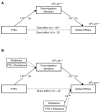Syrian Refugee Youth Resettled in Norway: Mechanisms of Resilience Influencing Health-Related Quality of Life and Mental Distress
- PMID: 34631646
- PMCID: PMC8494783
- DOI: 10.3389/fpubh.2021.711451
Syrian Refugee Youth Resettled in Norway: Mechanisms of Resilience Influencing Health-Related Quality of Life and Mental Distress
Abstract
Background: The importance of resilience factors in the positive adaptation of refugee youth is widely recognised. However, their actual mechanism of impact remains under-researched. The aim of this study was therefore to explore protective and promotive resilience mechanisms to inform future interventions and policy. Promotive resilience is seen as a direct main effect and protective resilience as a moderating effect. Methods: This was a cross-sectional study of Syrian youth recently resettled in Norway, aged 13-24 years. Regression and moderation analyses were used to explore different interactions, including moderated mediation using the PROCESS macro for SPSS. Result: A direct main effect of promotive resilience was found for health-related quality of life (HRQoL) and general mental distress, but not for post-traumatic stress disorder (PTSD). No moderating effects of protective resilience were found. Post-migration stressors mediated the effects of potentially traumatic events (PTE) from war and flight, and this indirect effect was present at all levels of resilience. Conclusion: Despite high risk exposure and mental distress, resilience was also high. Broad resilience interventions targeting multiple factors would likely benefit the group, but these should include both individual assets and building supportive environments. Additionally, reducing current stress and providing treatment for those in need could enable recovery and increase the efficacy of resilience factors already present.
Keywords: Syria; health-related quality of life; mental distress; post-migration stressors; post-traumatic stress disorder; refugee; resilience; youth.
Copyright © 2021 Dangmann, Solberg, Myhrene Steffenak, Høye and Andersen.
Conflict of interest statement
The authors declare that the research was conducted in the absence of any commercial or financial relationships that could be construed as a potential conflict of interest.
Figures




Similar articles
-
Health-related quality of life in refugee youth and the mediating role of mental distress and post-migration stressors.Qual Life Res. 2021 Aug;30(8):2287-2297. doi: 10.1007/s11136-021-02811-7. Epub 2021 Mar 13. Qual Life Res. 2021. PMID: 33713322 Free PMC article.
-
Post-Migration Stressors and Health-Related Quality of Life in Refugees from Syria Resettled in Sweden.Int J Environ Res Public Health. 2022 Feb 22;19(5):2509. doi: 10.3390/ijerph19052509. Int J Environ Res Public Health. 2022. PMID: 35270200 Free PMC article.
-
Mental health in adult refugees from Syria resettled in Norway between 2015 and 2017: a nationwide, questionnaire-based, cross-sectional prevalence study.Eur J Psychotraumatol. 2021 Dec 6;12(1):1994218. doi: 10.1080/20008198.2021.1994218. eCollection 2021. Eur J Psychotraumatol. 2021. PMID: 34900120 Free PMC article. Clinical Trial.
-
Post-traumatic stress disorder, depression, and anxiety in adult Syrian refugees: What do we know?Scand J Public Health. 2020 Nov;48(7):677-687. doi: 10.1177/1403494819882137. Epub 2019 Dec 8. Scand J Public Health. 2020. PMID: 31814514
-
Art Therapy Interventions for Syrian Child and Adolescent Refugees: Enhancing Mental Well-being and Resilience.Curr Psychiatry Rep. 2023 Dec;25(12):857-863. doi: 10.1007/s11920-023-01474-0. Epub 2023 Nov 9. Curr Psychiatry Rep. 2023. PMID: 37943430 Review.
Cited by
-
Protective factors associated with resilience among unaccompanied refugee minors after settling in Norway: a matched cross-sectional study.Eur Child Adolesc Psychiatry. 2024 Aug;33(8):2813-2822. doi: 10.1007/s00787-023-02364-9. Epub 2024 Jan 29. Eur Child Adolesc Psychiatry. 2024. PMID: 38285170 Free PMC article.
-
Resilience Mechanisms and Coping Strategies for Forcibly Displaced Youth: An Exploratory Rapid Review.Int J Environ Res Public Health. 2024 Oct 11;21(10):1347. doi: 10.3390/ijerph21101347. Int J Environ Res Public Health. 2024. PMID: 39457320 Free PMC article. Review.
-
Impact of COVID-19 on Neuropsychiatric Disorders.J Clin Med. 2022 Sep 3;11(17):5213. doi: 10.3390/jcm11175213. J Clin Med. 2022. PMID: 36079143 Free PMC article. Review.
-
Measurement tools used to assess individual health assets among refugee populations: a scoping review.Health Promot Int. 2025 Jan 17;40(1):daae199. doi: 10.1093/heapro/daae199. Health Promot Int. 2025. PMID: 39820457 Free PMC article.
-
Which Protective Factors Are Associated with the Mental Health of Syrian Students in Germany? A Register-Based Cross-Sectional Study.Int J Environ Res Public Health. 2022 Dec 3;19(23):16200. doi: 10.3390/ijerph192316200. Int J Environ Res Public Health. 2022. PMID: 36498273 Free PMC article.
References
-
- The Refugee Health Technical Assistance Center (RHTAC) . Resilience and Coping. (2021). Available online at: https://refugeehealthta.org/physical-mental-health/mental-health/adult-m... (accessed April 22, 2021).
-
- Keles S, Friborg O, Idsøe T, Sirin SR, Oppedal B. Resilience and acculturation among unaccompanied refugee minors. Int J Behav Dev. (2018) 42:52–63. 10.1177/0165025416658136 - DOI
MeSH terms
LinkOut - more resources
Full Text Sources

